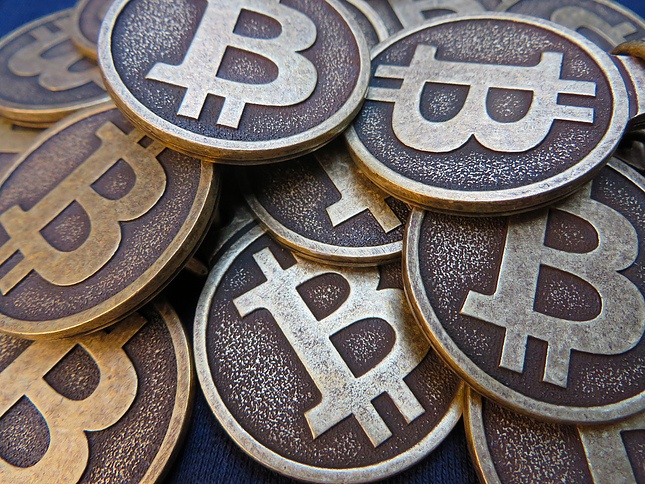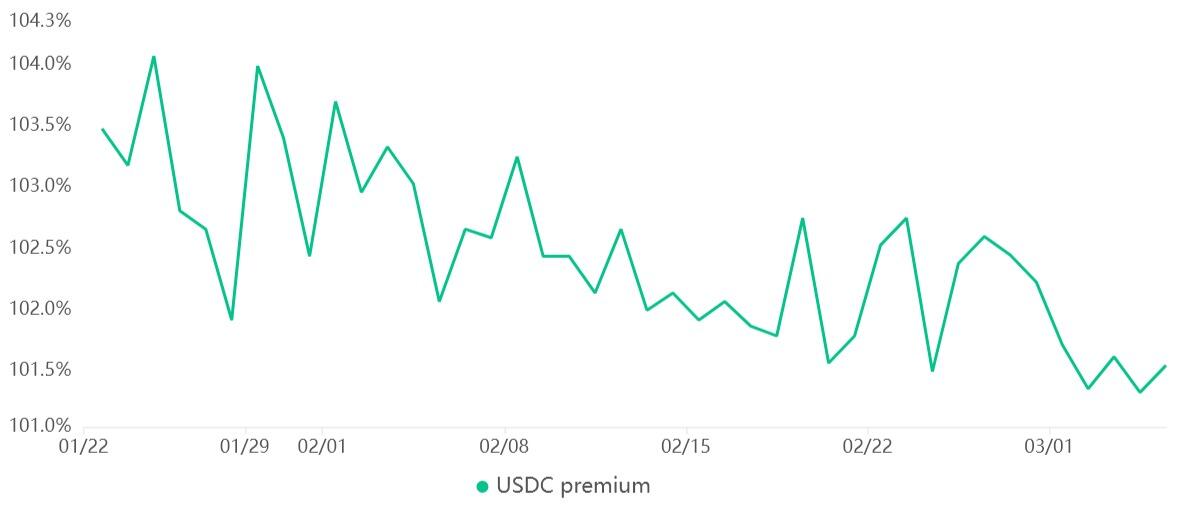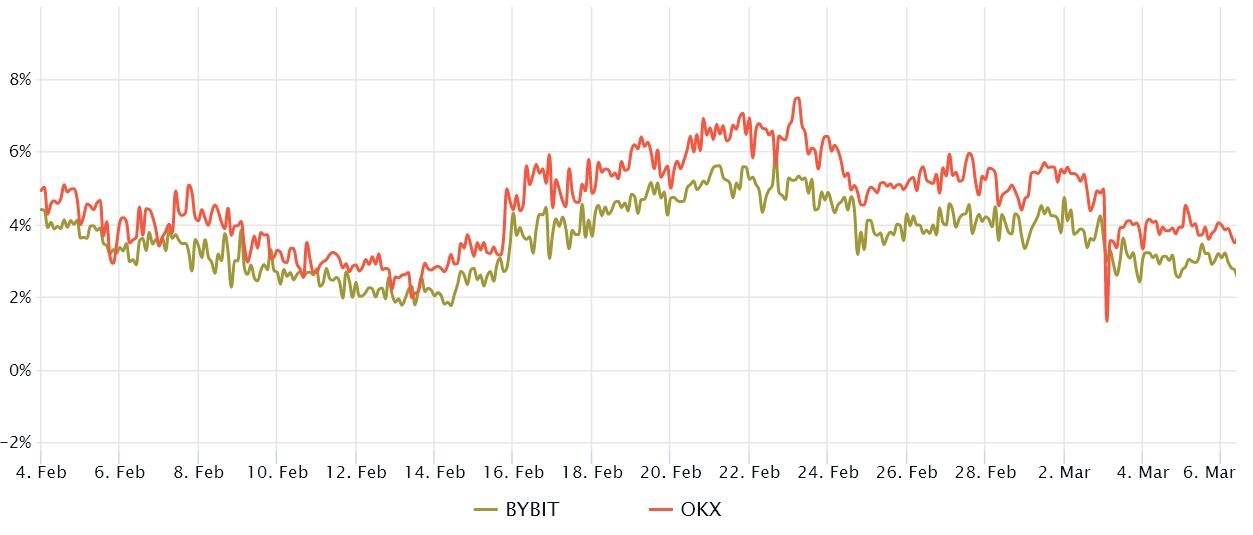BTC’s $1,420 decline in the span of 1-hour negatively impacted demand for stablecoins in Asia and it shifted futures traders into a more defensive attitude.
Bitcoin faced a 1-hour $1,420 pullback on March 3 following Silvergate Bank's 57.7% stock crash which was due to significant losses and "suboptimal capitalization." The U.S. fintech-friendly bank was a key financial infrastructure provider for exchanges, institutional investors and mining companies and some investors are worried that its potential demise could have wide-ranging negative impacts on the crypto sector.
The crypto-friendly bank discontinued its digital asset payment railway — Silvergate Exchange Network (SEN) — citing excessive risks. Silvergate also reportedly borrowed $3.6 billion from the U.S. Federal Home Loan Banks System, a consortium of regional banks and lenders, to mitigate the effects of a surge in withdrawals.
Among the impacted exchanges was Dubai-based Bybit, which announced the suspension of U.S. dollar transfers after March 10. The move follows Binance's international platform, suspending U.S. dollar fiat withdrawals and deposits on Feb. 6.
Fiat on and off ramps have always been a troublesome area due to the lack of a clear regulatory environment, especially in the U.S. Additional uncertainty came from the Wall Street Journal's March 3 report on iFinex, the holding company behind Tether and Bitfinex. Leaked documents and emails revealed the group relied on fake sales invoices and hid behind third parties to open bank accounts.
Despite a Wall Street Journal report alleging that Tether is being investigated by the Department of Justice, USDT is still the absolute leading stablecoin with a $71.4 billion market capitalization. The issue has spread across the industry as Paxos, the issuer of the third largest stablecoin, was ordered by the New York Department of Financial Services on Feb. 13 to stop issuing Binance USD (BUSD).
Let's look at Bitcoin derivatives metrics to better understand how professional traders are positioned in the current market conditions.
Derivatives metrics show buyers' shrinking appetite
Traders should refer to the USD Coin premium to measure the demand for cryptocurrency in Asia. The index measures the difference between China-based peer-to-peer stablecoin trades and the United States dollar.
Excessive cryptocurrency buying demand can pressure the indicator above fair value at 104%. On the other hand, the stablecoin's market offer is flooded during bearish markets, causing a 4% or higher discount.
USDC peer-to-peer vs. USD/CNY. Source: OKX
The USDC premium indicator in Asian markets has been slightly positive for the past three weeks but it is nowhere near the substantial 4% premium from early January. In addition, the metric shows weakening demand for stablecoin in Asia, which is down from 2.5% in the previous week.
Still, the present 1.5% premium should be interpreted as positive considering the bearish newsflow regarding the crypto-fiat payment railways.
Bitcoin's quarterly futures are the preferred instruments of whales and arbitrage desks. These fixed-month contracts usually trade at a slight premium to spot markets, indicating that sellers are requesting more money to withhold settlement longer.
Consequently, futures contracts should trade at a 5% to 10% annualized premium on healthy markets — this situation is known as contango and is not exclusive to crypto markets.
Bitcoin 3-month futures annualized premium. Source: Laevitas.ch
The chart shows traders abandoned any prospects of exiting the neutral-to-bearish area on March 3 as the basis indicator moved away from the 5% threshold. However, the current 3% premium is lower than last week's 4.5%, reflecting fewer investors' optimism.
On the bright side, the 6.2% drop in BTC price had a near unevental impact on Bitcoin futures markets. Higher demand for bearish bets using leverage would have moved the basis indicator to the negative area, known as backwardation.
Additional volatility is expected on March 14
In the week following Feb. 27, Bitcoin price lost 4.5%, indicating that investors are effectively worried about contagion from Silvergate Bank. Even if the crypto exchanges and stablecoin providers denied exposure to the troubled fintech, the cut-off from the fintech's payment processing system has raised uncertainty.
Analysts are now focused on the announcement of the Consumer Price Index (CPI) inflation data on March 14. Cointelegraph noted that CPI prints tend to spark short-term volatility across risk assets, although often short-lived in Bitcoin's price movements.
Derivatives metrics currently point to limited pressure from the Silvergate Bank saga, but the odds favor Bitcoin bears considering the diminishing demand for stablecoins in Asia and the BTC futures' premium.
Information on these pages contains forward-looking statements that involve risks and uncertainties. Markets and instruments profiled on this page are for informational purposes only and should not in any way come across as a recommendation to buy or sell in these assets. You should do your own thorough research before making any investment decisions. FXStreet does not in any way guarantee that this information is free from mistakes, errors, or material misstatements. It also does not guarantee that this information is of a timely nature. Investing in Open Markets involves a great deal of risk, including the loss of all or a portion of your investment, as well as emotional distress. All risks, losses and costs associated with investing, including total loss of principal, are your responsibility. The views and opinions expressed in this article are those of the authors and do not necessarily reflect the official policy or position of FXStreet nor its advertisers.
Recommended Content
Editors’ Picks

These 5 altcoins are rallying ahead of $16 billion FTX creditor payout
FTX begins creditor payouts on January 3, in agreement with BitGo and Kraken, per an official announcement. Bonk, Fantom, Jupiter, Raydium and Solana are rallying on Thursday, before FTX repayment begins.

ETH could see new all-time high in 2025 as blobs top burn leaderboard
Ethereum (ETH) is down 1% on Tuesday following a weeklong consolidation of the general crypto market. The top altcoin could be set for a bullish 2025 if blobs continue their recent trend of burning high amounts of ETH.

PEPE Price Prediction: Last-minute $121M whale demand sparks 1,500% 2024 rally
PEPE price surged 25% within the last 24 hours, decoupling from the broader crypto market’s year-end volatility. With whales spotted entering last-minute buying frenzy, can PEPE breach the $0.000025 resistance?

These three narratives could fuel crypto in 2025, experts say
Crypto narratives like Real-World Asset tokenization, Artificial Intelligence and Bitcoin as a treasury asset could gain relevance in 2025. Experts say meme coins could emerge as a key vertical next year and strike a cautious note about Solana and XRP ETFs.

Bitcoin: 2025 outlook brightens on expectations of US pro-crypto policy
Bitcoin price has surged more than 140% in 2024, reaching the $100K milestone in early December. The rally was driven by the launch of Bitcoin Spot ETFs in January and the reduced supply following the fourth halving event in April.

Best Forex Brokers with Low Spreads
VERIFIED Low spreads are crucial for reducing trading costs. Explore top Forex brokers offering competitive spreads and high leverage. Compare options for EUR/USD, GBP/USD, USD/JPY, and Gold.

